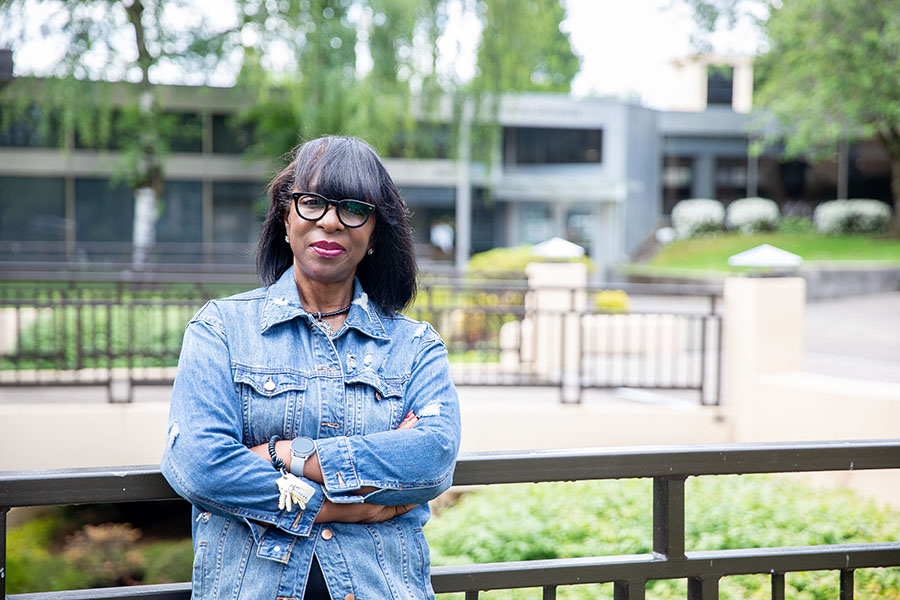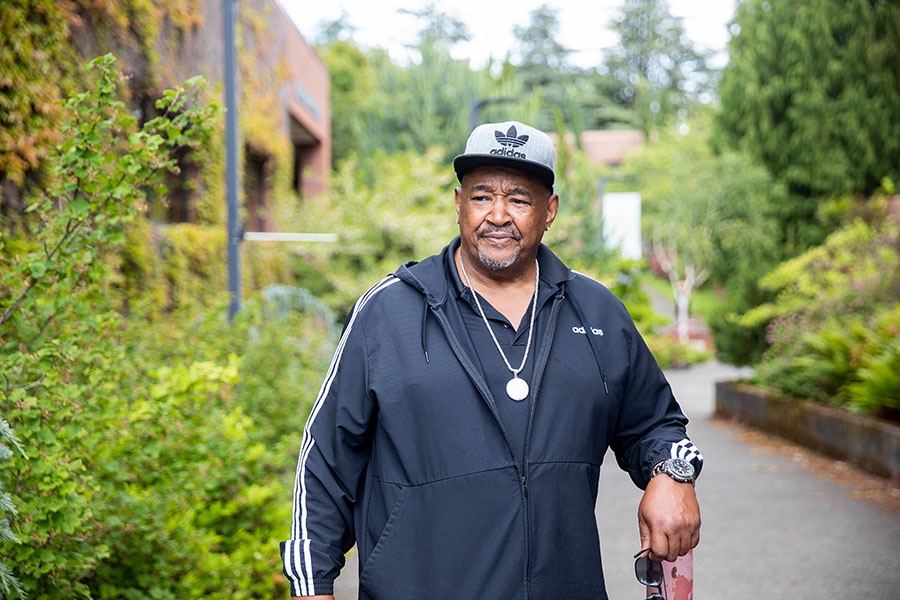A renewed national conversation about race, along with the COVID-19 pandemic, motivated health care providers to confront Oregon’s racial health care disparity.
The killing of George Floyd by Minneapolis police last May sparked months of protests and a renewed conversation about race relations across the country, including in Oregon. Companies across the state released antiracist statements, donated to social-justice foundations, held seminars on unconscious bias and committed to more inclusive hiring practices. The timing of Floyd’s death amid the COVID-19 pandemic made for a particularly intense reckoning in health care, as statistics showed the virus infected people of color disproportionately. Against that backdrop, policymakers, hospital systems and insurance providers have spent much of the last year rethinking how health care is delivered to diverse populations.
For health care providers in Oregon, addressing disparities in health care takes several forms: advocating for expanded insurance coverage, forming partnerships with community organizations, and taking steps to mitigate past injustices and close the racial wealth gap. Providers are also paying closer attention to the social determinants of health — the way socioeconomic circumstances can shape health outcomes — and using high-tech tools to gather data on those outcomes.
COVID-19 has brought Oregon’s racial health care disparities into stark relief, but the gap in outcomes isn’t new. According to a 2020 report from the Center for American Progress, people of color were more than twice as likely to develop chronic health conditions like diabetes, asthma and hypertension; lack medication for mental-health conditions; and suffer from obesity compared to whites. And in Oregon, Hispanic patients make up 20% of Oregon’s COVID-19 cases, despite being only 13% of the state’s population, according to data from the Oregon Health Authority. Black Oregonians have double the infection rate of whites, and the infection rate for Asian Americans is nearly triple.
“The racial divide was evident at the start of the pandemic, when the pandemic peaked — and now as people are being vaccinated,” says Serena Cruz, executive director of the Virginia Garcia Memorial Health Center, which operates five primary-care clinics in Washington and Yamhill counties. [Ed. note: Cruz has since changed employment.] The organization was founded in 1975 and named after the 6-year-old daughter of migrant farmworkers who died after a cut on her foot became infected — a death the clinic’s organizers attributed to a lack of culturally competent care. “There is no genetic predisposition to catching COVID-19. What we see is where people work, where they live and their access to health insurance is really making the difference when it comes to getting the virus.”
 Serena Cruz. Credit: Jason E. Kaplan
Serena Cruz. Credit: Jason E. Kaplan
In addition to having a higher COVID-19 positivity rate, nonwhite people are less likely to have health insurance. Even with the Oregon Health Plan, workers who are here legally can face waits of up to five years before they are eligible for Medicaid and CHIP benefits. Because of lower profit margins, business owners of color often find themselves priced out of employer-sponsored health insurance.
“The most significant issue for [employer-sponsored health care] is cost,” says Jan Mason, president of Oregon’s Philippine American Chamber of Commerce. “Many business owners of color are small- and medium-size companies, and have health vulnerabilities different from dominant-race-owned companies. Designing innovative and affordable health insurance could help.”
Cruz’s organization officially supports Cover All People, a House bill written by the Governor’s Racial Justice Council Health Equity Committee. The bill would allow the Oregon Health Authority to create a state-based health insurance option to medically underserved people regardless of immigration status. The public option would initially focus on serving parents who have children or dependents in the Cover All Kids program, a similar initiative targeting children.
Partnerships with community organizations are also essential to closing the racial health divide. Many communities of color have high levels of distrust for large health care systems and government agencies. That distrust is warranted, says John Washington, president of Portland’s Soul District Business Association, an advocacy group for Black business owners.
“During the time of Donald Trump, there was the implication from the administration that the virus was not as bad as it was when they knew it was killing certain demographics faster. I view it as intentional. But even if they didn’t spread the virus intentionally, they knew about it and did nothing to stop it,” says Washington. “That’s why people trust community organizations, because they stay engaged and put pressure on these institutions to provide credible information. You have to give people reason to trust you.”
Acknowledging the disparity in racial health outcomes and public trust means acknowledging Oregon’s history of redlining neighborhoods, depriving people of color access to business loans, racist use of eminent domain laws and other policies designed to keep nonwhite communities in poverty.
“You have households of color making $35,000 a year and white households that have established themselves and gotten ahead in the race making $92,000. Asking me why these health care disparities are so vast is like asking me why I have a nose,” says Washington. “So many of these mitigating factors, like stress, are the result of poverty.”
A 2010 analysis from the University of Wisconsin found medical treatment accounted for only 20% of factors relating to a sick individual’s health outcomes. Environmental factors such as income, education, stress and food quality accounted for the other 80%. According to a 2019 report by health care consultancy Healthbox, a person’s ZIP code had a greater impact on their overall health than their genetic code.
 John Washington, president of Portland’s Soul District Business Association
John Washington, president of Portland’s Soul District Business Association
Washington says Oregon’s racial health disparity cannot be fully addressed without also addressing the racial wealth gap.
“The first thing I would suggest large businesses start doing if they want to improve the health of the Black community is start frequenting Black businesses,” says Washington. “You can’t just write a check to a community organization and call it good. We have to mitigate these injustices.”
Washington also praised the Legacy Emanuel Medical Center’s Williams & Russell project. In August 2017, the hospital announced it would partner with Prosper Portland and the mayor’s office to develop a 1.7-acre lot in North Portland in a way that would economically benefit the historically Black neighborhood. During the 1970s, the hospital forced 171 families in the neighborhood out of their homes through eminent-domain laws for a planned expansion project. The families were not offered any financial compensation for the seizure of their land — and the expansion never happened.
Legacy Health is in the process of granting the land back to the community. The community has appointed eight people to serve on the Williams & Russell Project Working Group, the board tasked with guiding the land’s development.
Vicki Guinn, who leads public relations for Legacy Emanuel Medical Center, says the hospital’s decision to return the land was as much a financial decision as a moral one.
“Yes, we are a business, but we also live in the communities we serve. We see it as our goal to treat patients and also to raise the overall health of the community,” says Guinn.
 Vicki Guinn of Legacy Emanuel Medical Center. Credit: Jason E. Kaplan
Vicki Guinn of Legacy Emanuel Medical Center. Credit: Jason E. Kaplan
Legacy is not the only health care company encouraging housing and economic development as a means of improving health outcomes.
In 2020 Providence Health & Services committed $6.4 million to health services, employment services and housing projects in underserved communities as part of the Housing is Health initiative. Along with along with Providence, OHSU, Kaiser, Adventist Health, and CareOregon, the initiative raised $21.5 million for Central City Concern in Portland.
$1 million of Legacy Health’s contribution went to nonprofit organizations directly serving communities of color. Kaiser Permanente committed $8.15 million in grants to community organizations in 2020, $250,000 of which will go out as grants to Black-owned businesses in Oregon and Washington.
Legacy has also partnered with community organizations like Self Enhancement, Inc. and the Oregon Latino Health Coalition to better reach underserved communities.
“We view it as two-way education. It helps us better understand how to deliver health care, and it helps get them the information they need as well,” says Guinn, who says doing outreach through these organizations helps providers identify cultural disparities more quickly.
Collecting demographic data from community organizations has helped providers see the importance of employment, housing stability, and access to nutritious food and clean water to health care outcomes — allowing them to tailor messaging rather than take a “one size fits all” approach.
“When the pandemic first hit, the order to everyone was ‘shelter in place,’ but you have a lot of Black and Latino men and women who have to go in to work every day. And you’ve got multigenerational households with people living on top of one another. So the messaging we put out for the majority was inapplicable to them.”
Providence Medical Group has also begun screening all patients for social needs that affect health status, regardless of race, ethnicity, age, language or insurance status.
If needs are identified, patients are connected to a resource desk staffed by a local community partner organization to receive culturally responsive care and services.
Providence also employs a food-security outreach specialist who works with community partners to deliver food, grocery store vouchers, water, transportation vouchers and other basic needs. By providing members of underserved communities with necessities, health care systems can begin the long process of building trust.
“We need to create housing and access to nutritious food — everything that keeps people healthy and well,” says Bonnie Lerner, community health program manager at Providence Health & Services. “There are decades and decades of mistrust in the health care system, and very little has been done to restore trust. It’s urgent we work to repair the trust — and that work needs to be deliberate.”
More than one subject interviewed for this article expressed concern over whether health care systems’ zeal for racial equity will last, or if the surge in concern for health disparities is temporary.
But even if the grant money dries up, providers will likely continue to tailor care based on social determinants of health — and are using more sophisticated technology to identify those factors.
On June 14, the Research Triangle Institute in Washington, D.C., previewed HIMSS21, an artificial-intelligence tool that uses public data to identify factors contributing to poor health care outcomes in underserved communities. When tested, the tool was able to correctly identify between 73% and 99% of variations in health outcomes by examining social determinants of health. As more health care systems collect data from the populations they serve, predictive-intelligence tools like HIMSS21 become more precise.
If predictive software based on social determinants of health becomes commonplace, it may incentivize private health insurers to cover more patients and offer lower premiums. If health outcomes are shown to improve overall when more people have health coverage, the prospect of caring for poorer, sicker individuals could be seen as more lucrative since it reduces disease in healthier segments of the population.
Dr. Nick Kashey, Legacy Health’s interim vice president of population health, says the data surrounding social determinants of health is too critical to ignore. According to Kashey, improving patient environments to boost well-being is one of health care’s brave new frontiers.
“Slowly but surely, health care models are becoming health-management organizations rather than somewhere that just fixes things that are broken and sends people on their merry way,” he says. “None of this is a one-and-done.”
CORRECTION: A previous version of this story incorrectly stated Legacy Emanuel would retain ownership of the Williams & Russell development project. The land will be donated to the community completley.
To subscribe to Oregon Business, click here.









